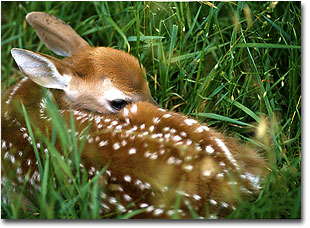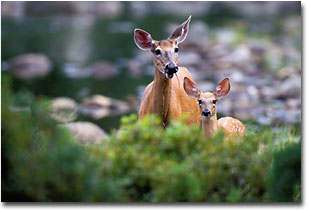Those who hunt a species soon discover that they enjoy greater success if they learn as much as they can about their quarry. It's no different for the serious wildlife watcher. And for those who want to get photographs, learning how to get close to wild subjects is as valuable as figuring out how to load film in a camera.
What do you need to know about a wildlife species in order to get better opportunities to camera hunt it? While the answer to that question varies with the species, some essential things that it helps to know about any species include:
- What does it eat? When? Where?
- What habitat does it prefer?
- Where does it sleep? When?
- Is it afraid of people?
- Is it dangerous to be around? At how close proximity?
- Is it only nocturnal? Is it also diurnal? Or does it come out even in daylight?
- Does it show itself on windy days?
- How well does it see? Hear? Smell?
- When does it mate?
- When does it give birth?
- Does it move seasonally? If so, where does it go? When does it return?
A good example of a species where such knowledge is important is the white-tailed deer. Since the season of whitetail births is upon us, and summer is a great time to photograph these beautiful creatures, it seems a good time to review some basics for one of the most widespread subjects available to the camera hunter.
 How much do you know about whitetails? Do you know what their best sense is for detecting intruder on their turf? Do you know how they react when they see people? Do you know if they naturally consider humans as a predator, something to avoid for safety?
How much do you know about whitetails? Do you know what their best sense is for detecting intruder on their turf? Do you know how they react when they see people? Do you know if they naturally consider humans as a predator, something to avoid for safety?
Most folks who have tried to photograph whitetails think that if they're hidden so that the animals can't see them, they'll be able to get close enough for good pictures. But anyone with a bit of experience with these deer soon learns that keeping one's scent from deer can be as important as hiding from them. Therefore, the knowledgeable whitetail photographers not only hide from wary deer, they work to keep the wind advantage.
Is a keen sense of smell the greatest of the whitetail's defenses? An oft-quoted Native American saying goes something like this: "A leaf fell in the forest. The eagle sees it, the bear smells it and the deer hears it." Anyone trying to get close to a whitetail needs to consider its acute sense of hearing as the first and foremost concern in trying to outwit a whitetail.
Simply understanding that they have incredibly good hearing, an extremely keen sense of smell and reasonably good vision, especially for things in motion, can help you use of the senses of the whitetail to your advantage.
How? First, understand that whitetails are very curious animals. They also know their home range - the specific areas in which they spend most of their lives - as well as you know your own living room. If something new appears in that range, it sticks out as the proverbial sore thumb. They will often approach it closer to determine what it is, at times dropping their head, then raising it quickly to see if the object moved, or perhaps to get a different angle of view on it.
They also respond with as much curiosity to strange sounds. Would you believe that a whitetail's inquisitiveness rises when it hears the click of a camera shutter? If you're trying to photograph a deer and you're concealed well enough to hide your human form, it might approach you after it hears that first click! But if it smells human scent or sees any motion it will likely bail out on you before you get push the shutter for a second shot.
 Every individual animal of any given species will also react based upon its experience with humans. You should know that you become part of that animal's experience as soon as you attempt to get closer to watch it. The cumulative life experience of any given white-tailed deer with close encounters of the human kind may well determine its response to its next meeting with Homo sapiens.
Every individual animal of any given species will also react based upon its experience with humans. You should know that you become part of that animal's experience as soon as you attempt to get closer to watch it. The cumulative life experience of any given white-tailed deer with close encounters of the human kind may well determine its response to its next meeting with Homo sapiens.
It also helps to know that if you pursue your wildlife photography activities in areas where the animals feel safer with humans, their response will be different from those of the animals who have been more heavily pressured by human activities. Wildlife photographers treasure those special places where man and whitetail can interact in harmony. Biologists sometimes refer to such animals as "habituated" to humans, and consider this as not to be natural behavior. While that could be debated, it's important for the serious wildlife watcher to know that places exist where wild deer feel more comfortable with human encounters. Learning how to identify such places is an important part of increasing your chances of photographing whitetails.
The wildlife photographer who wants to enjoy better camera hunting opportunities needs to learn how to seek out subjects that he or she can spend some quality time with. While some folks might satisfy themselves with a grab shot, the real whitetail photographer wants both lengthy and close encounters with these deer. Learn some of the secrets that will help you to do that, and you'll enjoy magic moments with these most graceful of the large land mammals of North America.
Catch yours in the good light.
BS-NPN 012
http://camerahunter.com
Comments on Bill Silliker, Jr.'s The Camera Hunter articles? Send them to the editor.
Maine wildlife & nature photographer Bill Silliker, Jr. – The Mooseman - photographed at many wild places in North America, with the results published in magazines internationally and in 9 of his own books. Bill was an instructor of wildlife and nature photography for L. L. Bean's Outdoor Discovery Program and a member of the Fuji Film Talent Team. Read more about Bill on the Camera Hunter archives page.



